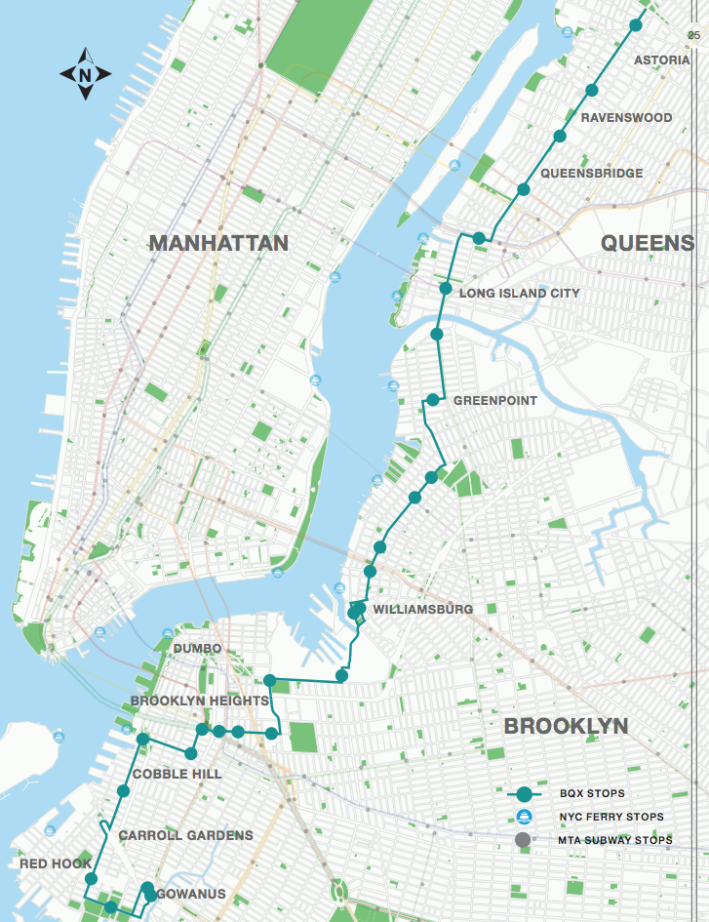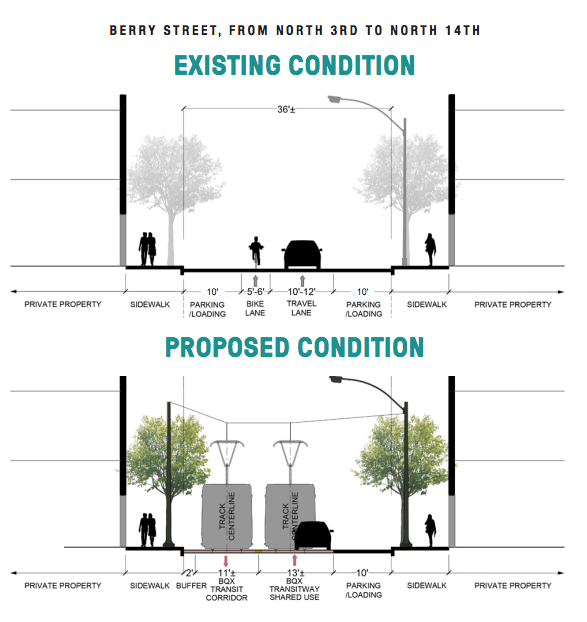More details have emerged about Mayor de Blasio's controversial Brooklyn-Queens Connector streetcar, one day after Streetsblog broke the news that the so-called BQX will be more expensive, take longer to build and cover less ground than its earlier version: the route has changed, Sunset Park isn't all that upset about being cut out of the plan, and the mayor can't wait for Donald Trump to be out of the White House so maybe he can get this streetcar financed.
Here's what you need to know:
Sunset Park is Out — and Happy About It
As Streetsblog reported, the city took Sunset Park out of the Astoria-to-Sunset Park route. A city Economic Development Corporation report [PDF] released Thursday attributes the decision to low anticipated ridership at the five stops proposed for the neighborhood.
Another possible explanation: Strong, organized opposition to the project among neighborhood residents — the members of community group UPROSE in particular.
"There's no doubt that Sunset Park was vehemently opposed to the BQX," local Council Member Carlos Menchaca told Streetsblog. "They saw this as a real estate developer-led project." (Which, by the way, it is.)

Menchaca claimed that the proposed Sunset Park route on Third Avenue would have forced small businesses to close, paving the way for developers to gobble up properties along the street. (The EDC report does not speculate on that.)
"These are immigrants, the backbone of Sunset Park," he said. "This would be the nail in the coffin for small businesses that need a development plan to support them, and not a kiss of death."
CONGRATS to @uprose staff ,volunteers, organizers,believers in justice who have our back! This is a victory- Let’s savor it for a second-We must now stand with working class along the corridor. Big ups to POWWA coalition We did this WE DID THIS! https://t.co/5kPY5nuoZk
— Your People at UPROSE (@UPROSE) August 30, 2018
The council member, who chairs the City Council's BQX task force, said there needs to be a comprehensive evaluation of transportation needs along the waterfront before the city moves forward with the project.
"We want something that can be done now. What this report is kind of hinting to is that it’s going to be a long time before we see this," he said, suggesting better bus service as an immediate and cost-effective solution.
In its report, EDC claims to have weighed buses as an alternative. For context, while the BQX is pegged at $2.73 billion, upgrading the entire B44 route on Nostrand Avenue — which carries around 40,000 riders -- only cost the city $15 million.
EDC says it rejected the bus option on the grounds that streetcars are more comfortable, better at navigating tight turns, and more likely to "support transit-oriented development at a scale that is typical along the corridor."
Downtown Brooklyn Replaces DUMBO
It's not exactly clear why the revised streetcar plan goes through congested downtown Brooklyn — and through the Willoughby Street pedestrian plaza — instead of DUMBO as originally promised.
The downtown Brooklyn route, which would run next to Atlantic Terminal in Fort Greene, would pull streetcar riders closer to the Long Island Rail Road and subway connections near Borough Hall. It also reduces the percentage of the route in high-risk flood zones.
The decision likely stems from higher ridership projections, according to Downtown Brooklyn Partnership Chief of Staff Belinda Cape.
"I've experienced first-hand the way that streetcars, pedestrians, and retail use can coexist to the advantage of everyone," said Cape, who hails from tram-heavy Melbourne, Australia. "If it’s done the right way, it can really lift a neighborhood."
Streetsblog has asked EDC for more information on the decision to remove DUMBO from the route.
Most, But Not All, of the Route Will Be Streetcar-only
Seventy percent of the proposed route will be on streetcar-only rights of way, without interference from private cars, according to EDC. Making sure that the remaining route is clear of obstructions — namely, double-parking — is crucial to the route's success. EDC hopes the streetcar will travel 12 mph. If it were just 4 mph slower, daily ridership would drop 40 percent, to 30,000, the agency says.
Given the NYPD's track record with enforcing bus lanes, the route will likely not reach its speed goal. Remember, the average speed of a bus in Queens is just 8 mph.
This cross-section of Berry Street in Williamsburg shows how challenging enforcement will be. The city wants to maintain local vehicular access, including a lane for parking and deliveries. Southbound vehicular access would be prohibited, but northbound traffic would be allowed to use the street for no more than "three to five blocks," and share a lane with the streetcar.
Experience in other cities that have installed 21st-century streetcar systems shows that vehicular obstructions can shut down service for significant chunks of time. Of course, many cities got rid of streetcars in the first place years ago to allow cars to dominate their streets.
Don't Count on Money From Trump
The project was initially priced at $2.5 billion, but now the price tag is $2.73 billion. And ground was supposed to be broken next year, but the start date is now 2024. It was also supposed to pay for itself through increased tax revenue thanks to the higher property values along the route.
Given the increased cost and news that the project won't "pay for itself" as proponents initially claimed, Mayor de Blasio has said that federal funding is imperative if the BQX is to become a reality.
Speaking to reporters on Thursday, the mayor suggested that the city may have to wait until Democrats take control of Congress or the White House.
"We're about to have two elections, 2018 and 2020, that could entirely remake the Congress and the White House, and then we'll be having an entirely different conversation about infrastructure" de Blasio said.
Streetsblog contacted the White House for comment, but nobody picked up the phone. (Seriously — it rang for two minutes.) We are continuing to reach out and will update this story if we get a response.







